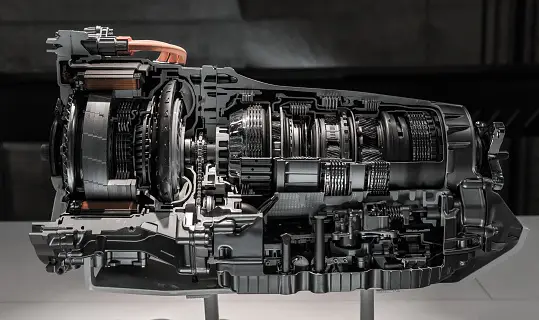September 5, 2023
What are the 3 types of transmission?
The three main types of transmission systems in vehicles are:
- Manual Transmission (MT):
- Also known as a “stick shift” or “standard” transmission.
- Requires the driver to manually select and engage the gears using a clutch pedal and a gear shifter.
- Offers greater control over the vehicle’s speed and power, as the driver can choose the appropriate gear ratio for different driving conditions.
- Generally provides better fuel efficiency than automatic transmissions but may require more skill to operate smoothly.
- Automatic Transmission (AT):
- Does not require the driver to manually shift gears; it changes gears automatically based on vehicle speed and throttle input.
- Uses a torque converter instead of a clutch to transmit power from the engine to the transmission.
- Offers a more convenient and user-friendly driving experience, as the driver can focus on acceleration and braking without worrying about gear changes.
- Typically easier to drive in heavy traffic or on hilly terrain.
- Continuously Variable Transmission (CVT):
- Uses a system of belts and pulleys to provide an infinite number of gear ratios rather than discrete gears.
- Offers smooth and seamless acceleration because it can constantly adjust the gear ratio to match the engine’s output and driving conditions.
- Often provides good fuel efficiency, as the CVT can keep the engine operating at its most efficient RPM (revolutions per minute).
- Some drivers may find the lack of traditional gear shifts disconcerting compared to manual or automatic transmissions.
Each type of transmission has its own set of advantages and disadvantages, and the choice between them depends on factors such as driver preference, intended use of the vehicle, and fuel efficiency priorities. Additionally, there are variations and hybrid systems that combine features of these three main types, such as dual-clutch transmissions and automated manual transmissions.

What is automatic CVT and DCT?
Automatic CVT (Continuously Variable Transmission) and DCT (Dual-Clutch Transmission) are two distinct types of automatic transmission systems used in vehicles. Here’s an overview of each:
Automatic CVT (Continuously Variable Transmission):
A CVT is an automatic transmission that doesn’t have traditional gears. Instead, it uses a system of belts and pulleys to provide an infinite number of gear ratios within a specified range. The key features of a CVT are:
- Infinite Gear Ratios: A CVT can vary the transmission ratio continuously, allowing the engine to operate at its most efficient RPM for a given driving situation. This can improve fuel efficiency and provide smoother acceleration.
- No Traditional Gears: Unlike automatic or manual transmissions, there are no fixed gears in a CVT. The transmission system continuously adjusts the ratio to optimize performance and efficiency.
- Smooth and Seamless Operation: CVTs are known for providing smooth and seamless acceleration, as there are no gear shifts. This can result in a comfortable driving experience.
- Good Fuel Efficiency: CVTs are often chosen for their potential to maximize fuel efficiency, as the engine can maintain an optimal RPM for various driving conditions.
However, some drivers find the lack of traditional gear shifts in CVTs less engaging compared to other transmissions, and there can be a sensation of the engine “revving” when accelerating.
Dual-Clutch Transmission (DCT):
A DCT is an automated manual transmission that uses two separate clutches for odd and even gears. It can shift gears more quickly than a traditional automatic transmission and provides some of the advantages of manual transmissions without requiring the driver to operate a clutch pedal. Key features of a DCT include:
- Two Clutches: A DCT has two clutches—one for even-numbered gears and one for odd-numbered gears. This allows for pre-selecting the next gear, enabling faster and smoother shifts.
- Quick Shifting: DCTs can shift gears very quickly, resulting in faster acceleration and improved performance compared to traditional automatic transmissions.
- Fuel Efficiency: DCTs often offer better fuel efficiency than traditional automatic transmissions due to their efficient gear changes.
- Sporty Feel: DCTs are often used in sports cars and performance vehicles because of their rapid and precise gear changes, providing a sporty driving experience.
While DCTs are known for their performance benefits, some drivers may find them less smooth at low speeds or in heavy traffic compared to traditional automatic transmissions.
In summary, Automatic CVTs are characterized by continuously variable gear ratios for smooth and efficient operation, while DCTs use two clutches to provide quick and precise gear changes, often in a sportier driving context. The choice between them depends on the driver’s preferences and the vehicle’s intended use.

Is a car transmission the gearbox?
Yes, in the context of a car, the term “transmission” often refers to the gearbox. The transmission is a critical component of a vehicle’s drivetrain that serves the purpose of transmitting power from the engine to the wheels, allowing the vehicle to move at different speeds and in different driving conditions.
The transmission contains a set of gears (either manual gears in a manual transmission or various gear ratios in an automatic or CVT transmission) that can be engaged or disengaged to control the distribution of power from the engine to the wheels. This gear-shifting mechanism is what enables the driver to control the speed and performance of the vehicle.
So, when people talk about a car’s transmission, they are usually referring to the gearbox or the transmission system as a whole, including the gears, clutches, torque converter (in an automatic transmission), and related components that manage the power flow from the engine to the wheels.
